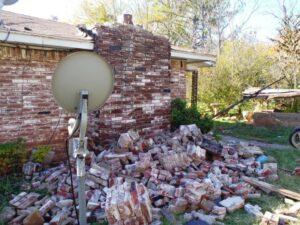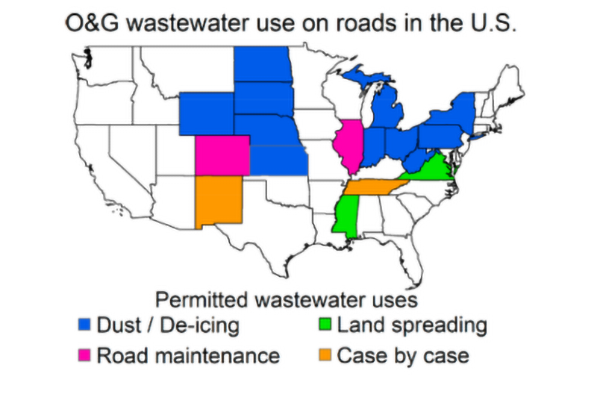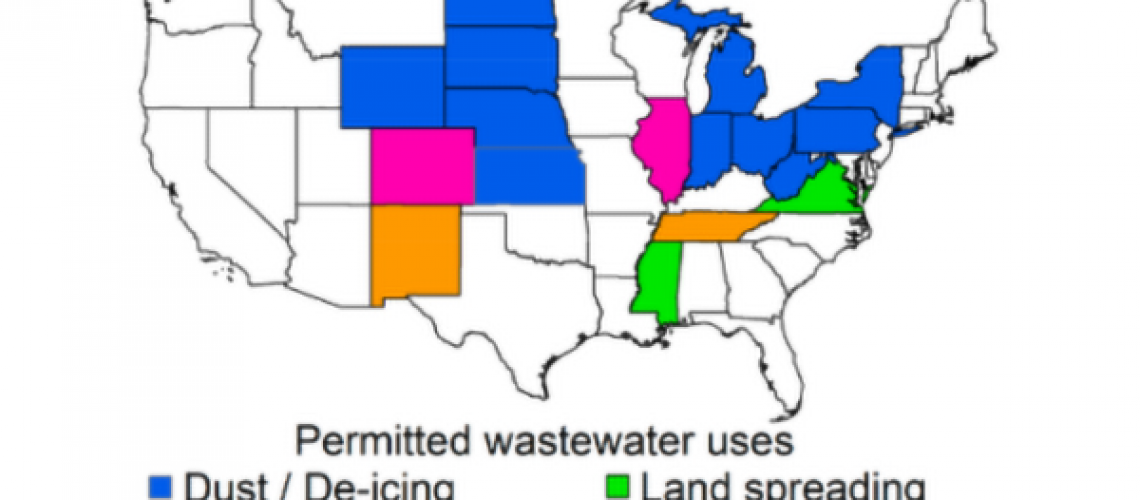By Molly Mclaughlin, 2018-2019 Sustainability Leadership Fellow and Ph.D. Student in the Department of Civil and Environmental Engineering
Many people know that fracking, or hydraulic fracturing, for oil and gas uses water, but did you know that it also extracts water? In fact, most oil and gas wells generate water – even the old wells you see pumping on the side of the highway. Oil and gas wastewater, also known as produced water, formation water or fossil water, is naturally present in the oil and gas bearing formation. Similar to when you mix oil and water in a glass, the gas, oil and water are separated underground. The wastewater contains many of the chemicals found in oil and gas formations including salts, metals, oil and gas, and naturally occurring radioactive materials, such as radium. Because this fluid is highly contaminated with a variety of chemicals, many of which are toxic and challenging to remove, oil and gas wastewater has generally been viewed as a waste product.
The most common disposal method for oil and gas wastewater is underground injection, where the fluid is injected thousands of feet underground, below currently used water aquifers. This practice, however, has been connected with higher frequency and higher intensity earthquakes, most infamously in Oklahoma. For example, prior to 2013, there were an average of two 3.0-magnitude earthquakes per year in Oklahoma. After 2013, there were an average of two per week. Communities there and throughout the U.S. are demanding that oil and gas companies find new, safer ways to manage this waste stream.

Increasingly, many groups, including oil and gas companies, the federal government, state governments and even small towns, are interested in reusing oil and gas wastewater. This can mean a variety of things – from reuse in the oil field to reuse on a corn field. The federal government is currently conducting a study on oil and gas wastewater management, with a particular focus on reuse in arid states. New Mexico has recently entered into a non-binding agreement with the EPA, known as a memorandum of understanding (MOU), to look into “re-use, recycling and beneficial use of waters originating from oil and natural gas activities.” The draft white paper for this MOU explores a range of possible scenarios including reuse within the oil and natural gas industry, surface water discharges, industrial and commercial sales outside the oil and natural gas industry, agricultural uses, municipal uses and subsurface discharges for groundwater management.
In some parts of the U.S., reuse of oil and gas is already occurring. For example, in Kern County, California, which was the top agricultural producer in the country in 2017, about 10% of fields have been irrigated with diluted oil and gas wastewater for decades. Recent media attention on this practice has concerned many people, since food grown in this area is shipped throughout the U.S. Studies to determine the impacts of this practice have started, but are not completed yet. Additionally, due to its high salt content, many states use oil and gas wastewater for road spreading to suppress dust. The map below shows states where this and other land spreading practices are in place. One study that investigated this practice showed that it can lead to increased run off of salts and radium, both of which can negatively effect the health of fish and other aquatic animals.

The community where I conduct my PhD research is in an arid part of the West. Decades ago, there was enough water to support cattle and horses. Now, with a changing climate and increased demand on water resources in the area, they use oil and gas wastewater to water the cattle and horses. Without reuse of this wastewater, ranchers would be unable to support their livestock and their livelihood. Besides ranching and oil and gas, there aren’t many job opportunities in the area. Results from this site have shown that some oil and gas wastewater is better for reuse than others. The concentrations of chemicals in oil and gas wastewater can vary widely throughout the U.S., making analysis and regulation that much more complicated. For example, in some areas this water has a salt content similar to that of drinking water (< 1000 mg/L), but in other areas, salt content is 10 times greater than seawater (400,000 mg/L). Results have also shown that chemical analysis is not enough to determine the health implications of this water. Additional biological studies, known as bioassays, are needed to determine both short-term (e.g. death) and long-term (e.g. cancer, low-birthweight) impacts to animals, including fish, humans and other species. With so much unknown, will more communities implement this practice? And how does this potential water source complicate the debate around oil and gas in arid communities?
To date, studies have shown that there are issues with this practice and that there is a lot we don’t know. More research on impacts and treatment methods are needed to determine if this practice can be conducted safely. Many argue that while we figure it out, oil and gas operators should focus solely on water reuse within the industry (i.e. not agriculture). If this water can be safely reused, many stakeholders will benefit. If reuse of this water is not fully understood prior to mass implementation, however, our water and soil resources could be irrevocably harmed. My research is one step in a life-cycle approach to the costs and impacts of oil and gas extraction and is a part of a growing trend to look at the full cost of developing an energy source.






